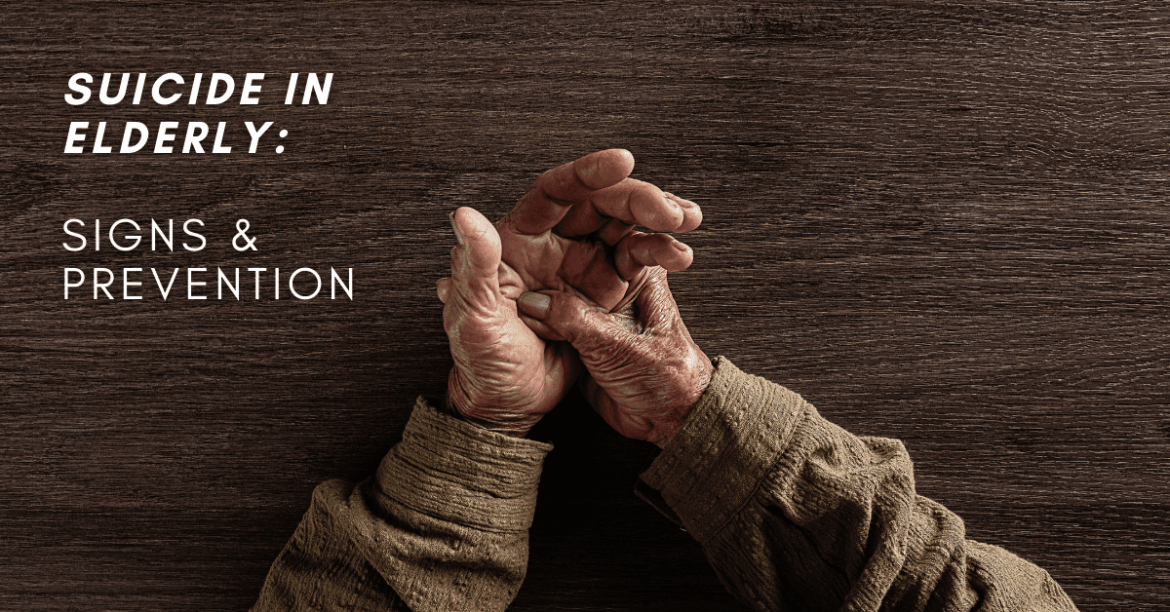It was a beautiful Sunday morning, and the birds chirped outside as Abby walked into the nursing home to visit her grandfather. As she made her way down the hallway, she noticed something was off. Her usually cheerful grandfather was sitting in his room with the curtains drawn and the lights off. When she asked him what was wrong, he simply replied, “I’m just tired.”
As the day went on, Abby couldn’t shake the feeling that something wasn’t right. Her grandfather seemed more withdrawn than usual, and she noticed he wasn’t eating or drinking much. When she tried to engage him in conversation, he brushed her off and said he just wanted to be left alone.
It wasn’t until later that evening that Abby received a call from the nursing home staff. Her grandfather had attempted to take his own life by overdosing on medication. Thankfully, they had caught him in time, and he was receiving medical attention, but Abby couldn’t help feeling shocked and devastated.
Unfortunately, Abby’s story is not unique. Suicide rates in the elderly are on the rise, with almost 18% of the total suicide deaths in the USA being older adults. In this blog post, we’ll explore some of the common warning signs of suicide in the elderly, as well as strategies for promoting mental health and intervening when necessary.
What are the risk factors and causes of suicide in elderly?
There are several risk factors that may contribute to suicidal tendencies in senior individuals. Each person’s experience is unique, and different risk factors can contribute to the cause of suicide in elderly. Some of the most common ones include:
1. Physical and mental health conditions
Chronic pain, long-term illness, and disability can take a toll on an individual’s mental health and increase the risk of suicidal thoughts. Besides, depression, anxiety, and other mental health conditions are common in the elderly and can also increase the risk of suicide.
2. Social isolation and loneliness
As people age, they may become more socially isolated due to factors such as retirement, the loss of a spouse, or physical limitations. It can lead to a feeling of loneliness and depression, which can contribute to suicidal ideation.
3. Financial difficulties
Some elderly individuals may struggle financially, particularly if they are living on a fixed income or have high medical expenses. Financial stress can exacerbate mental health problems and increase the risk of suicidal ideation.
4. Substance abuse
Substance abuse is another risk factor for suicide in people of all ages, and elderly individuals may be particularly vulnerable due to factors such as increased access to prescription medications.
5. History of trauma
NIH study suggests elderly individuals who have experienced trauma or abuse in their lives may be at higher risk of suicidal ideation.
What are the warning signs of suicide in elderly?
It’s important to remember that suicidal ideation is not a normal part of aging and is always a cause for concern.
1. Behavioral changes
Several behavioral warning signs may indicate that an elderly individual is at risk of suicide. These signs may not always be obvious, and some may hesitate to discuss their thoughts or feelings with others. So, it’s essential to pay close attention to any unusual changes in behavior or mood. Some of the behavioral warning signs of suicide in elderly include:
- Lose interest in hobbies, activities, or people they used to enjoy spending time with.
- Give away their belongings or express a desire to “clean house” or get rid of things.
- Stop taking care of their personal appearance, neglect personal hygiene, or stop taking medications as prescribed.
- Engage in reckless behaviors such as driving too fast or drinking alcohol excessively.
- Start preparing for their death, such as updating their will, writing goodbye letters planning for their funeral, or disposition of remains.
2. Emotional changes
Here are some potential emotional changes and warning signs of suicide in elderly individuals:
- Express feelings of hopelessness or despair
- Become more anxious or agitated, experience panic attacks, or have trouble sleeping.
- React more strongly to minor irritations or frustrations.
- Express feelings of being a burden to others.
- Show signs of sadness and cry more often than usual.
3. Physical changes
Here are some potential physical changes and warning signs of suicide in seniors:
- Complain about unexplained physical symptoms, such as headaches, stomachaches, or muscle pain.
- Show a significant decrease in energy level or appear to be more lethargic than usual.
- They may engage in self-harm behaviors such as cutting or neglecting their physical health by refusing to take medications.
- Experience a loss of appetite or eat more than usual.
4. Social changes
Here are some potential social changes and warning signs of suicide in the elderly:
- Withdraw from social interactions, such as stop attending events or religious services.
- Lose interest in maintaining relationships with friends and family members.
- They may stop answering phone calls, emails, or text messages.
- Lose interest in hobbies.
Elderly suicide prevention: things to do
Elderly suicide prevention is an important issue that requires a range of interventions and strategies. Here are some things that can be done to prevent suicide among the elderly:
1. Identify and address risk factors
The first and foremost step is to identify risk factors for suicide among the elderly. That may include social isolation, depression, chronic pain, and physical illness, and address these factors through appropriate interventions.
2. Increase social support
Social support can be a protective action against suicide. Encouraging the elderly to engage in social activities, connect with family and friends, and participate in community groups can help reduce isolation and increase social support.
3. Access to mental health services
Mental health services, including counseling and psychotherapy, can be effective in treating depression and other mental health conditions that can increase the risk of suicide. Additionally, consulting with a professional, such as an occupational therapist or home safety expert, could be beneficial.
4. Education and awareness
Educating the elderly, their families, and caregivers about the warning signs of suicide and the importance of seeking help can be an effective strategy for preventing suicide.
5. Medication management
Elderly individuals are often prescribed multiple medications, which can increase the risk of adverse drug reactions and interactions. It is important to ensure that medication management is closely monitored and that patients are educated about the potential risks associated with their medications.
6. Support groups
Providing support groups for the elderly can be an effective way to increase social support and reduce social isolation. Support groups can also provide a safe and non-judgmental space for individuals to share their experiences and feelings.
7. Crisis intervention
Ensuring that crisis intervention services are available to the elderly can be critical in preventing suicide. This includes providing access to crisis hotlines and emergency services.
8. Home safety measures
Ensuring that the home environment is safe and free from hazards can help reduce the risk of suicide. For example, storing sharp objects (e.g., knives, scissors) and hazardous materials (e.g., rat poisoning, cleaning products) in a secure location.
9. Ongoing monitoring
Regular monitoring of the elderly, particularly those who are at high risk of suicide, can help identify warning signs and enable early intervention. It can also be done through installing technological features such as security cameras, tracking devices, etc.
10. Collaborative care
Collaborative care between healthcare providers, family members, and community organizations can help ensure that the elderly receive comprehensive and coordinated care that addresses their physical, mental, and social needs.
Does Medicare cover mental health services?
Mental health services can be costly, and many older adults rely on government support to cover those expenses. Luckily, Medicare covers a range of mental health services for eligible beneficiaries.
Medicare Part A may cover inpatient mental health care such as hospital stays or treatment psychiatric unit and similar settings.
Under Medicare Part B, outpatient services are covered where beneficiaries are entitled to receive mental health services from a licensed professional, such as a psychiatrist, psychologist, or clinical social worker.
Medicare Part D also covers certain mental health medications such as antidepressants, antipsychotics, and mood stabilizers.
Suicide prevention helplines
Suicide prevention helplines provide immediate access to trained professionals who offer confidential support to individuals in crisis or distress. This professional support is important for creating a safe and non-judgmental space for individuals and families to seek help.
Here are some suicide prevention helplines and their contact details in the USA:
- National Emergency Number: 911 is the 24/7 national hotline for any kind of emergency situation.
- Crisis Text Line: Text HOME to 741741. This is a free, confidential, and 24/7 text-based crisis hotline that provides support and resources for individuals in crisis or distress.
- 988 Suicide & Crisis Lifeline: Provides 24/7 confidential, free support to people going through emotional distress, including hard-of-hearing individuals.
- Veterans Crisis Line: Dial 988 or 1-800-273-8255 (Press 1). This is a free, confidential, and 24/7 hotline that provides support and resources for veterans in crisis or distress, as well as their loved ones.
- The Trevor Project: 1-866-488-7386. This is a free, confidential, and 24/7 hotline that provides support and resources for LGBTQ+ youth in crisis or distress.
- Trans Lifeline: 1-877-565-8860. This is a free, confidential, and 24/7 hotline that provides support and resources for transgender individuals in crisis or distress.
- SAMHSA Disaster Distress Helpline: 1-800-985-5990. This is a free, confidential, and 24/7 hotline that provides support and resources for individuals who have been affected by a natural or human-caused disaster.
Final thoughts
In conclusion, suicide is a serious issue that affects people of all ages, including seniors. The warning signs can be subtle and often go unnoticed, which is why it’s important for family members, caregivers, and healthcare providers to be aware of these signs and take appropriate action.
By identifying and addressing risk factors, increasing social support, providing mental health services, and using suicide prevention helplines, we can help prevent suicide among the elderly. We hope this blog will help raise awareness about elderly suicide and the importance of prevention measures. So that more people will be empowered to take action and support the elderly in their communities.
By working together, we can help reduce the incidence of suicide among the elderly and ensure that they receive the care and support they need to live healthy and fulfilling lives.
FAQs
- How can we reduce the stigma around mental health in the elderly?
Here are some strategies that can be effective in reducing the stigma around mental health in the elderly:
- Encouraging open communication
- Challenging stereotypes
- Providing access to care
- Engaging community leaders
- Promoting positive images of aging and mental health
- Reducing language that reinforces stigma
- Highlighting successful older adults with mental health challenges
- Encouraging intergenerational interactions and support
- Is it common for elderly individuals to experience depression or anxiety?
Depression and anxiety are among the most common mental health conditions experienced by older adults. According to Healthline, an estimated 7 million Americans aged 65 and older experience depression, while an estimated 2 million experience anxiety.
- Can medication or therapy be effective in treating suicidal ideation in the elderly?
Medication and therapy could be effective in treating suicidal ideation in the elderly. For example, antidepressant medications and cognitive-behavioral therapy (CBT) can help improve mood and develop coping skills. But the effectiveness of treatment may depend on various factors, and it’s vital for individuals to work closely with healthcare providers to develop a comprehensive treatment plan.

